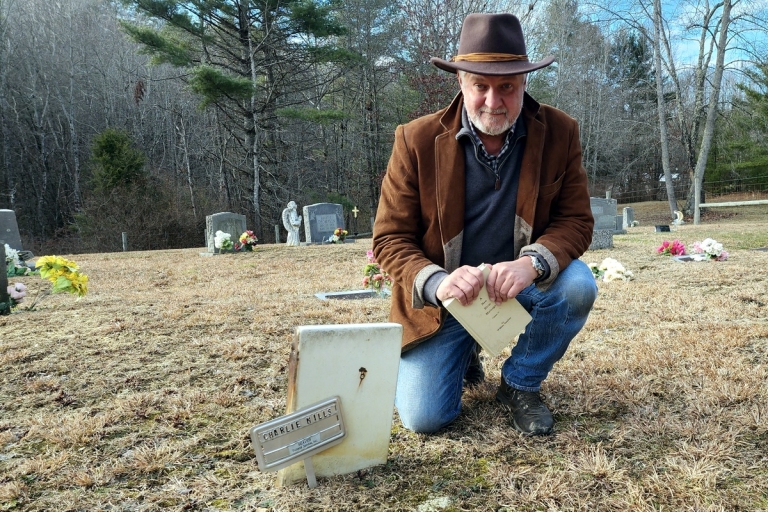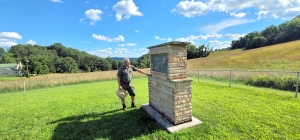
CAMP CREEK, W.Va. — Only a few local historians may remember the obscure and chilling tale of Charles Anderson Mills, more infamously known in the neighborhood of Nubbins Ridge in Mercer County as "Likker Charlie."
A ruthless moonshiner who, on his deathbed, confessed to the violent murders of dozens of victims, Mills and two of his sons tyrannized the mountainous countryside for more than 50 years, according to the late attorney William Sanders.

Laid to rest in a country cemetery with a nameless scrap-metal headstone, Mills was perhaps, even then, provided more honor than he deserved, according to Sanders, who recounted some of the unpleasant but essential history in the fourth volume of his series "A New River Heritage."
"In the severe economy that followed the Civil War and in the first days of timber harvesting—following the earliest coal mining, when wages had not been established—the moonshine business was a mainstay of life for many of the Flat Top Mountain families," Sanders wrote.
"Open season prevailed between the moonshiners and the revenue officers for many years. Many a life was rubbed out — "Shot at a still!" — whether maker, buyer, or bystander, from ambush."
The turmoil of the period set the stage for the tragic life of Mills, who had worked for several mining companies and the Bluejay Lumber Company but lived chiefly as a moonshiner.
Sanders derived part of Mills's history through the late Reverend Roger West, a "kind of father-confessor" to the Mills family. However, Sanders also represented son Zack Mills as an attorney.
According to Sanders, Mills died in about 1949 or 1950 in a cabin built for him by a son near the head of the Mash Fork of Camp Creek in what's now Camp Creek State Forest.
"In the house that Guy built on the head of Camp Creek, it took him about two weeks to die, during which time he was bedfast in torment," Sanders wrote. "In his hallucinations, he related many of the killings which had been attributed to him over the years without any prosecutions for his crimes."
"Guy Mills, standing on the porch, was heard to say to his brother Zach, "Why don't we go in there and kill the old man? He's telling everything he knows on us."
Some of the following passages from a section of the volume entitled "The Fable of Likker Charlie Mills" are here presented in a lightly emended form for readability.
- "He killed his son-in-law Boyd Shrewsbury, whose riddled body fell across a brush fence because he made better moonshine." On his deathbed, he repeated to West that "he always hated killing Boyd," and on his deathbed, he told his son Guy to "go up there and get Boyd off that fence so I can die." Also, in the two weeks of torment, he said, "Boyd was running over him with a bicycle and showing him every bullet hole he had put in him."
- "With relation to another alleged act of murder of a young couple that was traveling through the Bluff Mountain about the turn of the century whose bodies were found much later, and Mills and his wife were observed in the community as wearing jewelry and fine apparel that had formerly adorned the young couple," Anderson repeated in his dying declarations, "Now, Lord, my brother did that. I didn't do it." He had also discussed this alleged crime with West about 1927 when he was West's foreman in the Bluejay Lumber activities.
- Another crime attributed to Anderson was the killing of a pack peddler shoe salesman on "Lonely Bluff Mountain."
- "During his dying days, he hallucinated about killing the illegitimate child of his daughter Rosie by sticking a hatpin into the soft spot of her head and its brain. He would pantomime, holding the baby in his arms and rubbing its head, saying, "Poor little thing wanted to live."
- "At one time, he bragged of killing several scab miners during strike activities in the Elkhorn Mine and one time professed to fellow worker Roger Mills that he blew up the Pocahontas Mine. He had told of burning sulfur behind the fan of the mine to asphyxiate miners and professed to have cut the heads off several murdered scab workers and placed them on pikes as an example."
Sanders wrote that Zack and Guy Mills were nearly as violent as their father and were unpredictable when drinking, "especially in the drinking of the various homemade brands of moonshine."
- "Zack told West he had shot a man when he came through his doorway after telling him not to knock the door down and that he did not shoot the man, but that the man ran into the bullets when he knocked the door down."
- "Guy killed a man when he returned to his home and found the man there and instantly killed him with a ball peen hammer with repeated blows to his head. In a mad fit, when Phyllis Harvey was a child visiting the home, Zach shot his mother in the leg through the door."
- "Zach and Guy fought like dogs between themselves on frequent occasions. Each acquired a fearful reputation like that of their father. In one fight, Zack struck Guy in the head with an ax, giving him a lifetime scar on the top of his head."
- "The killing of Mingo Farley at the drawbars along Mash Fork in the present state park is also attributed to Guy, who beat Mingo to death with a hammer."
Despite their nature, Sanders seems to have had an amiable, professional relationship with Zack. Sanders would not have been intimidated. A decorated marine who had been awarded a Purple Heart, Bronze Star, and Navy Cross in the Pacific Theater, he was, by all accounts, fearless in the courtroom and countryside.
"I represented Zack Mills over the years after he was severely burned in the fire of a shanty where he was serving as a night watchman in a lumber operation. He remained greatly scarred about his hands and face for the rest of his days.
"He took up with a girlfriend, said to be an American Indian named 'Tootsie,' who was his constant companion for many years. While he and Tootsie were in a tavern at Spanishburg, two young fellows were making light of him and her over his disfigurement. They were probably interested in obtaining the cash that Zack carried around and displayed too conspicuously. After warning them to cease, he shot them both. Their wounds were not fatal. I represented him and cleared him on self-defense grounds.
"Near their time of death, Zack and Tootsie came to Roger West, telling him they were dying and going to hell, and sought his help. Roger states that they were both bawling, and both of them got down in the dust and prayed near the chapel across from Roger's home, stating they were not worthy of going in the church proper."
Charles Anderson Mills and his wife, Mary, are buried in the Peyton Cemetery at Peyton Place off Nubbins Ridge Road (Google coordinates: 37.469146, -81.171894). Their graves are conspicuous in their coarseness—two pieces of enameled scrap metal in front of which two metal funeral markers have been added. Sanders never said why the Millses are honored in such a way.
Little-known Farley Monument recalls origins of family

Of the thousands of people named "Farley" who can claim to hail from southern West Virginia, almost all come from one place —"Old Farley," a quiet village where their ancestor, Drewry Farley, settled. Farley and his wife, Mary (Adkins) Farley, established their family in an upland pasture overlooking the New River at the summit of what's long known as Shockley Hill. READ THE FULL STORY HERE.
Sign up for a FREE West Virginia Explorer Magazine copy in your weekly email. Sign me up!































